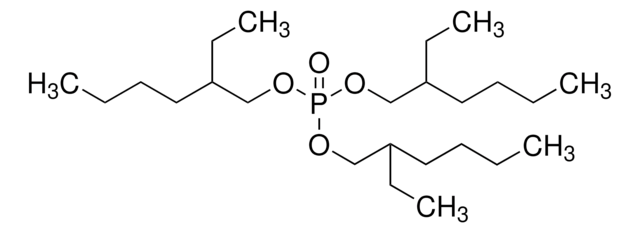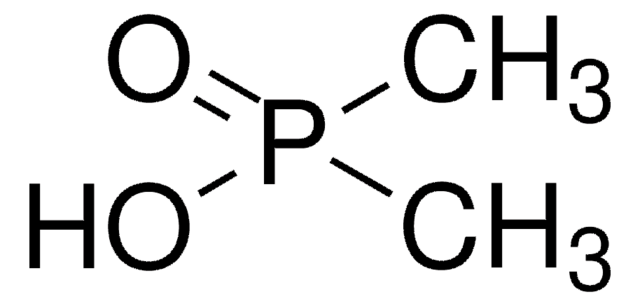68572
Dibutyl phosphate
≥97.0% (T)
Synonym(s):
Phosphoric acid dibutyl ester
Sign Into View Organizational & Contract Pricing
All Photos(1)
About This Item
Linear Formula:
(CH3CH2CH2CH2O)2P(O)OH
CAS Number:
Molecular Weight:
210.21
Beilstein:
607224
EC Number:
MDL number:
UNSPSC Code:
12352100
PubChem Substance ID:
NACRES:
NA.22
Recommended Products
Quality Level
Assay
≥97.0% (T)
form
liquid
density
1.06 g/mL at 20 °C (lit.)
functional group
phosphate
SMILES string
CCCCOP(O)(=O)OCCCC
InChI
1S/C8H19O4P/c1-3-5-7-11-13(9,10)12-8-6-4-2/h3-8H2,1-2H3,(H,9,10)
InChI key
JYFHYPJRHGVZDY-UHFFFAOYSA-N
Looking for similar products? Visit Product Comparison Guide
General description
Dibutyl phosphate, also known as Phosphoric acid dibutyl ester, is an organophosphate compound with a long alkyl chain that is commonly used as an organocatalyst for polymer synthesis via ring-opening polymerization of cyclic esters and to catalyzed transesterification reactions.
Application
Dibutyl phosphate can be used as a reactant to synthesize:
- Glycosyl phosphates by using 1,2-orthoesters.
- 2-Aminophosphatesvia catalyst-free regioselective and enantiospecific SN2-type ring opening reaction with aziridines.
Features and Benefits
- Inherently biodegradable
- Stable in neutral, acidic, or alkaline solutions
Signal Word
Danger
Hazard Statements
Precautionary Statements
Hazard Classifications
Carc. 2 - Eye Dam. 1 - Skin Corr. 1B
Storage Class Code
8A - Combustible corrosive hazardous materials
WGK
WGK 1
Flash Point(F)
352.4 °F - closed cup
Flash Point(C)
178 °C - closed cup
Personal Protective Equipment
dust mask type N95 (US), Eyeshields, Gloves
Choose from one of the most recent versions:
Already Own This Product?
Find documentation for the products that you have recently purchased in the Document Library.
Customers Also Viewed
S Maji et al.
Spectrochimica acta. Part A, Molecular and biomolecular spectroscopy, 64(4), 972-976 (2006-02-21)
The fluorescence of Tb(3+) is sensitized by complexation with dibutylphosphate (DBP) and tri-n-butylphosphate (TBP). The excitation maximum for the Tb(3+)-DBP complex occurs at 218.5 nm, while that for the Tb(3+)-TBP complex is observed at 228.0 nm. Both complexes yield Tb(3+)
Y Nishimura et al.
Journal of biochemistry, 118(1), 46-55 (1995-07-01)
Organophosphate compounds are known to cause a selective increase of beta-glucuronidase activity in rat serum. Previous data suggested that increase of serum beta-glucuronidase activity was well correlated with decrease of that activity in rat liver microsomal fraction, thereby, suggesting a
[Determination of mono- and di-N-butylphosphoric acids in their mixture using 2 indicators].
F A Bogdanov et al.
Gigiena i sanitariia, (4)(4), 63-65 (1990-04-01)
Neal B Gallagher et al.
Applied spectroscopy, 60(7), 713-722 (2006-07-21)
Multivariate curve resolution (MCR) is a powerful technique for extracting chemical information from measured spectra of complex mixtures. A modified MCR technique that utilized both measured and second-derivative spectra to account for observed sample-to-sample variability attributable to changes in soil
Liqin Hu et al.
Chemosphere, 233, 724-732 (2019-06-15)
Organophosphate flame retardants and plasticizers (OPFRs) are widely additives in consumer products and building materials. They are frequently detected in environmental media, including indoor air, water, soil, and dust. To provide a low-cost and multi-target tool for monitoring individual exposure
Our team of scientists has experience in all areas of research including Life Science, Material Science, Chemical Synthesis, Chromatography, Analytical and many others.
Contact Technical Service


![1,8-Diazabicyclo[5.4.0]undec-7-ene 98%](/deepweb/assets/sigmaaldrich/product/structures/120/564/5b373e23-1624-489c-8efb-692de0f96ffb/640/5b373e23-1624-489c-8efb-692de0f96ffb.png)




![1,4-Diazabicyclo[2.2.2]octane ReagentPlus®, ≥99%](/deepweb/assets/sigmaaldrich/product/structures/366/129/a6ff4175-974d-4fac-9038-b35e508ef252/640/a6ff4175-974d-4fac-9038-b35e508ef252.png)





